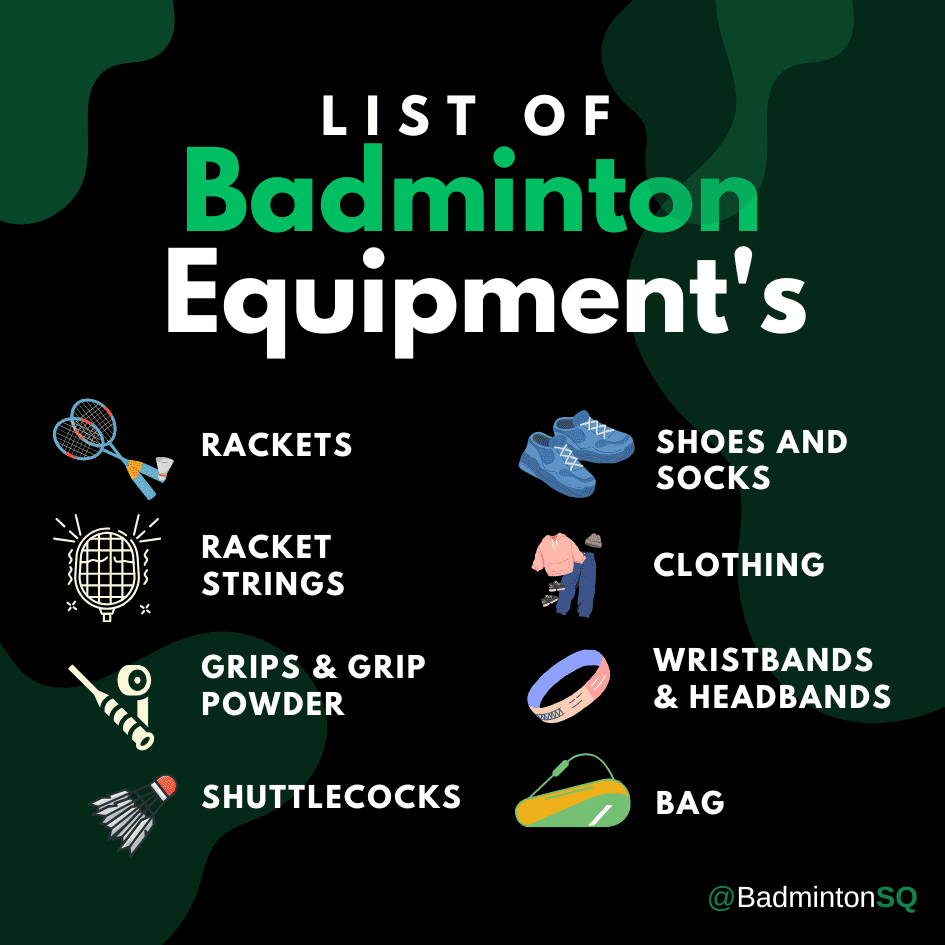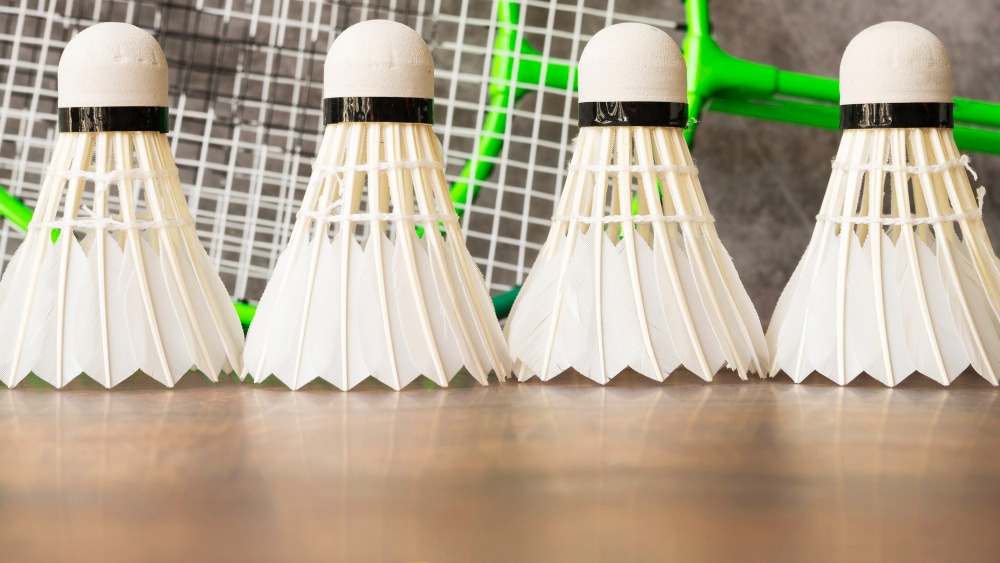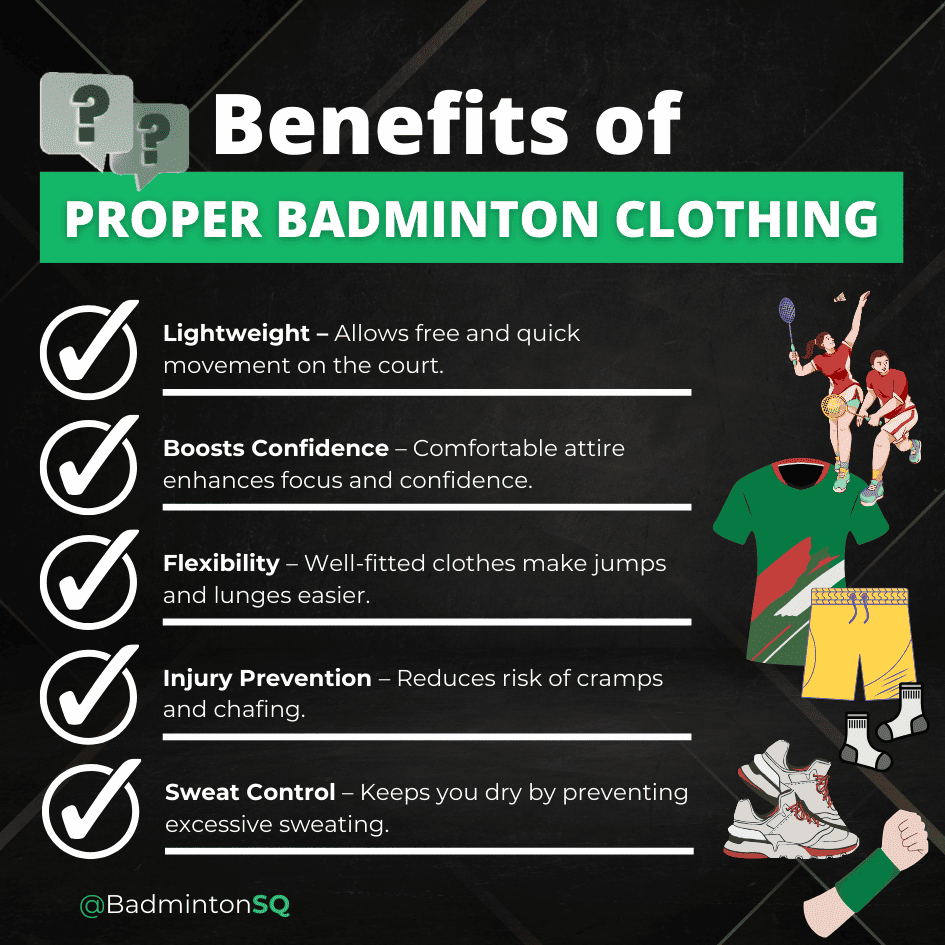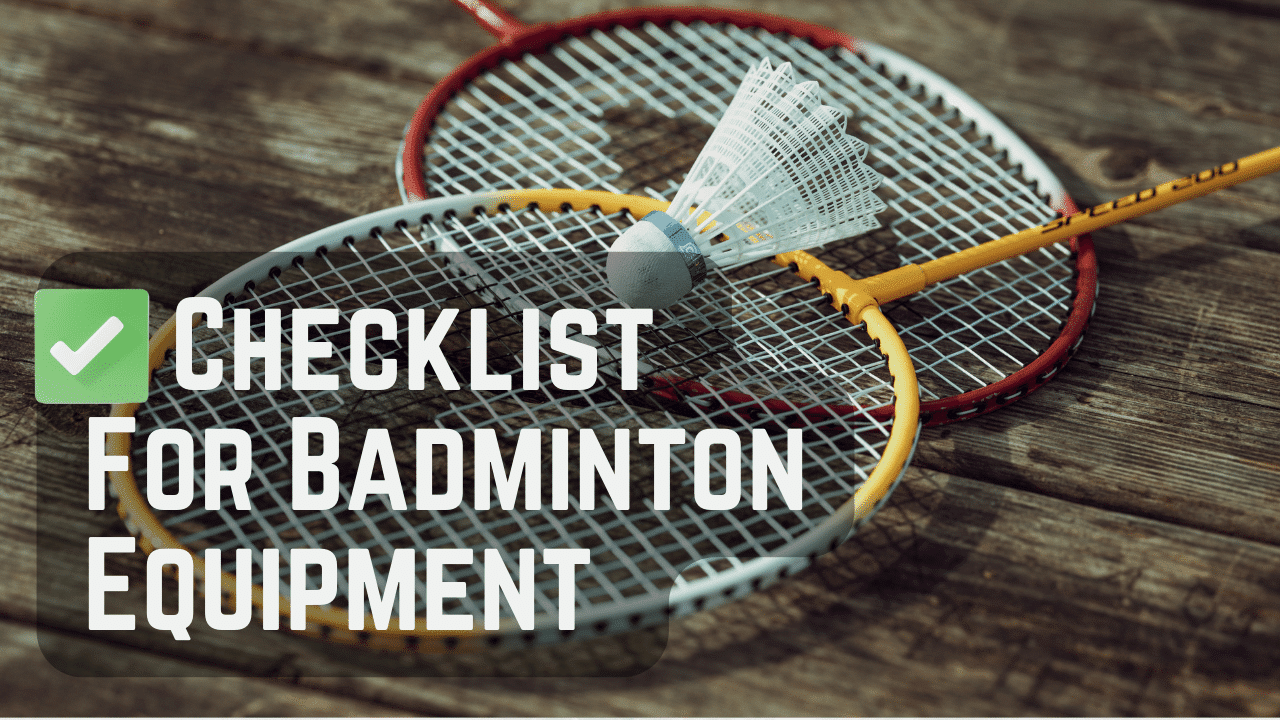Are you planning to start playing badminton?
Or do you want to upgrade your badminton equipment list?
You are just at the right place. I will share pinpoint tips on how to buy the best badminton equipment and walk you through the ideal specifications of each piece of equipment.

Here’s a list of badminton equipment that we are going to discuss.
- Rackets
- Racket Strings
- Grips
- Grip Powder
- Shuttlecocks
- Shoes and Socks
- Clothing
- Wristbands
- Headbands
- Knee Cap
- Bag
- Tracker
If you are a beginner, you won’t need all of these. I will help you understand what equipment you should prioritize for badminton sport.
So, let’s get started and learn about badminton equipment that every player must have.
Rackets
You’ll obviously need a racket to get started with badminton. Many players have complained about being unsatisfied with their play because they chose the wrong racket. That’s why it is absolutely necessary to select the right racket for you.
Now, this is not some magic trick that will let you know this is the perfect racket just by holding it. You have to try out a few different things before you settle on one.

Racket Material
Start with the material. Badminton rackets are made with different types of material. These include:
- Aluminum
- Carbon
- Tungsten
- Graphite
Aluminum rackets are heavier, but they give more power to the shot. Meanwhile, graphite rackets are lighter, but they provide more flexibility.
Weight
The weight of your racket is another thing to consider. You should start out with a low-weight racket, around 70 to 80 grams. When you get a hang of it, move on to heavier rackets. Most high-quality rackets weigh between 83 to 100 grams.
There are rackeys that weigh more than 100 grams. These are not used in regular matches. They are used to increase your wrist strength. They can weigh between 120 to 180 grams.
Based on the weight, badminton rackets can be categorized into the following types:
| Racket Category | Racket Weight (in grams) |
| F | 70 – 74.9 |
| 2U | 75 – 79.9 |
| 3U | 80 – 84.9 |
| 4U | 85 – 89.9 |
| 5U | 90 – 94.9 |
Note: This size chart is for rackets of the Yonex brand. The size chart could vary from brand to brand, so make sure to consult the brand-specific size chart before you buy.
Shape
The head of the racket comes in two shapes.
- Oval
- Isometric
The isometric shape has a 30% bigger sweet spot (The spot used to hit the shuttle without banging it in the edges.). So, beginners might prefer that shape. However, professionals have more control over their rackets and are okay with the small sweet spot on oval-shaped rackets.
Balance
There are three types of balance in a badminton racket.
- Head Heavy: The head of the racket is heavier than the handle.
- Even Balance: The mass is evenly distributed between the handle and the head.
- Head Light: The handle of the racket is heavier than the head.
Racket Strings
Badminton racket strings are of several types. They come in varying sizes of diameters. Thinner strings have more power, but they are not that durable. Thicker strings have less power, but they are more durable.
Material
These come in three types of material – nylon, synthetic gut, and natural gut.
- The nylon and synthetic gut strings are more durable, require less maintenance, and are affordable.
- The natural gut strings are made from animal intestines. They have superior power and control. They are more expensive and require strict maintenance. These are usually used by professional players.
String tension
String tension is how tightly the strings are wound. It is measured in pounds. The higher the pounds, the higher is the string tension. It can be set according to your expertise level.
Here’s a table showing expertise level and appropriate string tension.
| Expertise level in badminton | String tension (in lbs) |
| Beginner | 17 to 20 |
| Intermediate | 20 to 24 |
| Advanced | 24 to 27 |
| Professional | 27 to 30+ |
Grips
A grip is placed on the handle of a racket so you can hold it properly without slipping. There are three main types of grips.
- Rubber grip
The rubber grip is the one that usually comes attached to the racket. It is good for leisure games or light practice. It is not durable or robust.
- Towel grip
A towel grip is made of synthetic rubber. Its outer portion is a layer with cotton or other absorbent material. It is perfect for sweaty hands as it easily absorbs moisture.
- Over grip
These are thin grips that can be wrapped over the original grips. They can be wrapped multiple times to increase the thickness of the handle.
Grip Powder
Grip powder is used to give your hands more grip while using a towel grip. This is especially useful if your hands sweat a lot and the towel grip is not sufficient to absorb all that sweat. This powder is usually made of Magnesium Carbonate Hemihydrate.
Remember: This powder is only suitable for towel grips. If you use it with synthetic or rubber grips, your hands will become more slippery.
Shuttlecocks
A true badminton shuttlecock is made up of sixteen feathers. There are three types of features used.
- Real feathers
In a real feathers shuttlecock, fuck or goose feathers are used.
- Synthetic
In a synthetic feather shuttlecock, feathers are made of either plastic or nylon.
- Hybrid
A hybrid shuttlecock is made by using both the real feathers and synthetic materials. This is a more recent development in badminton equipment.

Besides this, there are shuttlecocks of different speeds. Which one you should choose depends on three factors.
- Altitude
- Humidity
- Temperature
The table below will give you a better idea about which shuttlecock is right for you.
| Shuttlecock Number | Shuttlecock Speed | Temperature of region (in ℃) | Altitude |
| 75 | Very Slow | >30 | Above Sea Level |
| 76 | Slow | 25-30 | Sea Level |
| 77 | Average | 15-25 | Sea Level |
| 78 | Fast | 0-15 | Below Sea Level |
| 79 | Very Fast | <0 | Below Sea Level |
Shoes and Socks

Shoes
Badminton shoes are very different from regular sports shoes. Most beginners ignore this and wear regular shoes. There’s no harm in it until you crash into the net while defending a drop shot because you were not able to get the traction you need. Pretty embarrassing, isn’t it?
That’s why you must get specialized badminton shoes. Actually, you can wear tennis shoes on a badminton court because they have mostly the same qualities. Speaking of qualities, a good pair of badminton shoes must have the following:
- Good grip on the sole
- Provide sufficient traction
- Are stable enough to hold your body weight
- Lightweight
- Non-marking grip (Don’t leave scratch marks on the floor due to vigorous movement.)
- Enough cushioning to prevent minor scratches and injuries
- Provide more lateral support
- Extremely comfortable
- Breathable material with proper ventilation
- Must have good shock absorption capacity
These shoes are designed to be used indoors. They are best for playing on wooden and tiled floors. Some players also use heel cups to prolong the lifespan of their shoes.
Socks
You sweat a lot while playing badminton, especially on your feet. That’s why it is important to wear water-absorbing material. Your socks must be made of cotton or any other material that can soak sweat.
Avoid wearing non-absorbing materials like nylon because your feet will become slippery due to unabsorbed sweat. There’s a good chance that your feet will slip out of the shoes. That will be a disaster, especially if you are in the middle of a rally.
So, choose your socks wisely.

Clothing
Badminton clothing for men includes shorts and T-shirts. For women, shorts, skirts, skirts, and t-shirts are permissible. You can buy a jacket to wear outside the court while doing your warm-up or cool-down exercises.
General clothing guidelines for badminton
There are some general guidelines that you should follow while buying badminton clothing. Those are:
- Get lightweight and breathable fabric that can quickly absorb sweat.
- The fabric must dry off quickly, or you will feel wet and sweaty throughout the match.
- Avoid fabrics like cotton that absorb and hold moisture for a long duration. They don’t dry off as quickly as necessary.
- Don’t wear full pants and full-sleeved T-shirts, as they can hinder the complete movement of your body.
- Don’t wear loose-fitting clothes as they will create friction against your body and start chafing.
- Avoid wearing tight-fitting clothes as they will restrict your movement.
- Buy clothes that are well-fitted – Not too tight or loose.
- Women can wear tight shorts under their skirts if they feel that the skirt might bounce up during the match.
- Avoid wearing dark colors in warm climates as they might absorb heat from the surroundings.
Clothing rules for professional games
When you play for leisure or in a non-competitive environment, there are no restrictions on how your clothing should look. However, in professional games, certain rules are laid out by the club or the tournament organizers. These rules are mostly the same for all competitive matches. The rules are as follows:
- The color of your clothing must not match your opponent’s.
- In a doubles match, your partner and you must wear the same color clothing.
- Your clothing design must not be related to any other sport like football, rugby, hockey, etc.
- Any graphics, images, or written content that promote any brand are banned unless explicitly sponsored by the tournament’s organizers.

Benefits of wearing proper badminton clothes
The following are the benefits of including a proper set of clothing in your badminton equipment list:
- They are lightweight, which gives you room to move around freely and quickly.
- Proper clothing can boost your confidence as you feel comfortable.
- Properly fitted clothes allow easy jumps and lunges.
- Badminton attire prevents the risk of injuries like muscle cramps and chafing.
- They prevent excessive sweating, and you dry off quickly.
Accessories
By now, we have covered all the necessary equipment for badminton. Now, we will move on to some items that are not absolutely necessary but good to have. They will aid in playing better by giving you the support you need. Let’s take a look at some of these accessories.
Wristbands
As the name suggests, wristbands are bands worn around the wrists by badminton players. The purpose of these bands is to prevent sweat from tickling down to the handle of your racket. It is not compulsory to wear a wristband. Players who sweat excessively prefer to use them.
Badminton wristbands must be made of absorbent materials. They should be able to soak up sweat quickly without causing a slippery scene. These are usually worn only on the dominant hand (The hand in which you hold the racket.).
It is good to have a few wristbands handy in case it gets a little humid and warm. There’s no limitation on the size and color of the band to use. But do try on the size so they don’t slip off your hand because they are too big or don’t press your wrist too tight because they are small in size.
Headbands
Headbands serve a similar purpose as the wristbands.
- They prevent sweat from trickling down your forehead and entering your eyes.
- If you have bangs or long hair that could come in your eyesight, these bands could keep them away. Just tuck this hair inside the headband, and you should be all right.
- If you wear spectacles, it’s a good idea to wear headbands so moisture doesn’t get near your eyes and fog your glasses.
Headbands need to be of soft absorbent material to quickly absorb the sweat. Make sure they are lightweight so your head doesn’t feel too heavy.
They should be tight but not too tight that they will leave marks behind. It shouldn’t be loose otherwise, it will fall down on your eyes during the game.
Knee Cap
Knee caps are not as common as wristbands and headbands in badminton. A kneecap is worn for two purposes.
- You have a knee injury.
- Your knee hurts after playing.
Knee caps have a way of compressing your knee muscles so you don’t pull one during the game. Some of them are even shock absorbent. They are even flexible to allow easy movement.
Although, some players complain that their full motion is restricted due to the right fabric of the knee cap. That’s the major reason that it’s not common to wear one. You can use a knee cap as a preventative measure for knee injuries if you are comfortable with the movement restriction.
Bag
A badminton bag should be big enough to fit all your badminton equipment. That includes the rackets. There are racket-shaped bags specially designed to hold the rackets. But if you want all your equipment in a single bag, it should be big enough.
After the size, look for the strength of the bag. All the equipment together can get a bit heavy. Your bag must be able to handle that weight. Check if the straps are strong enough.
Also, check that the bag doesn’t concentrate all its weight in a single location. This can cause shoulder pain while carrying the bag. The weight must be evenly distributed throughout the strap.
Another thing to check is the compartments. Mang bags have this single large compartment where you randomly dump your stuff. But it is good to have proper compartments for different badminton equipment. Check if the bag has these compartments and if they are sufficient to hold all your belongings.
Tracker
A tracker is the most recent addition to badminton equipment. This is not widely used yet because the programs that they run on are still very basic versions. Many players use these to test the product or implement the results into their own strategy.
So, first of all, we need to know..
What is a badminton tracker?
It is a portable device that you can attach to your racket. It has a wireless sensor that tracks your play. It records the power of your swing, your movement pattern, etc. and analyzes your game strategy. All the recorded data is transferred online to a mobile app connected to the tracker.
Some trackers take it a step further. Instead of simply presenting the gathered information, they give you personalized feedback. They suggest ways in which you can do better. In a way, it’s a kind of personalized training and coaching.
These trackers are very lightweight. They weigh approximately 6 grams. But still, some players feel that it makes their racket heavy. They use a lithium-ion battery, which is long-lasting and rechargeable. Just plug it in to charge when the tracker is low on battery and use it again when charged.
It is a great badminton equipment to use for training. You can self-analyze your play and learn to do better. These trackers might not be allowed in competitive matches as they might give you an edge over your competitors. You can confirm with the organizers to avoid any last minute trouble.
Assemble the Badminton Kit
You now know all the necessary badminton equipment. You will need to carry most of these times to your every session. It is necessary that you build a good kit so you have everything you need right there.
So, a good badminton kit must include:
- A spare racket
- A set of strings
- 2-3 grips
- Can of grip powder
- 2-3 extra shuttlecocks
- At least 2 wristbands
- At least 2 headbands
- A knee cap just in case
- An extra T-shirt
- An extra shorts/skirt
- A towel to wipe the sweat
- A filled water bottle
- Your badminton shoes
- An extra pair of socks
- A jacket in case you get cold
- Sweets (in case you need a glucose bump)
- Band-aids
- Pain relief spray/cream
- Any other prescription medications that you feel are necessary
- Some snacks if you prefer to eat before or after the match
- A badminton tracker (if you want one)
Now you know how to choose the right badminton equipment. Select the products that are suitable for your style and skill set. There’s no need to overspend on equipment like grips and trackers if you are playing for leisure or just starting out. Start by getting a racket and a shuttlecock, and build your kit from there.
You can get really good badminton equipment on a budget. You just have to find the right product that will suit your needs. Don’t forget to thoroughly check all the product specifications to avoid buying the wrong product.
Happy Shopping!
FAQs
What are the five basic materials and equipment used in playing badminton?
The five basic materials and equipment used in playing badminton are:
1. Rackets 2. Shuttlecock 3. Net 4. Shoes 5. Clothing
What is there in a badminton kit?
A badminton kit includes all the necessary items that you will require for your game. These include all the equipment, accessories, and other small things like water bottles and towels.
What is badminton net height?
A badminton net height is 5.1 feet in the center and 5 feet on both sides. It kind of bulges in the center, sloping on the sides.
What are badminton accessories?
Any badminton equipment besides the rackets, shuttlecock, shoes, and clothing are known as badminton accessories. These could include grips, towels, headbands, wristbands, trackers, etc.
Why are there two types of shuttlecock?
There are two types of shuttlecocks in badminton to let the player practice at different paces. Beginners use synthetic shuttlecocks because they are lightweight, durable, and affordable. It’s okay if they get damaged quickly, which is common in the beginning days. Advanced players use real feather shuttlecocks, which are the ones used in professional matches. They are more expensive comparatively, which is why beginners don’t prefer them.
What is the color of a shuttlecock?
Most shuttlecocks are white in color. They might have a band on the cork of a different color to indicate the speed of the shuttlecock.
